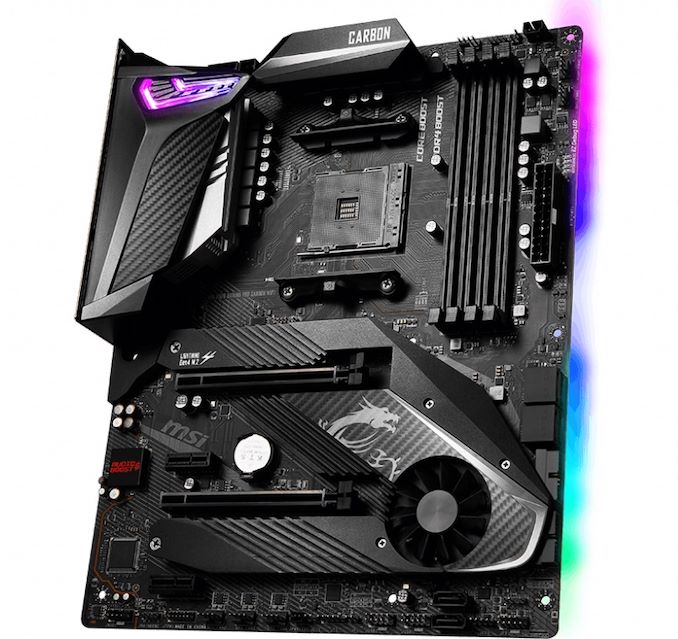The AMD X570 Motherboard Overview: Over 35+ Motherboards Analyzed
by Gavin Bonshor on July 9, 2019 8:00 AM ESTMSI MPG X570 Gaming Pro Carbon WIFI
The MSI MPG X570 Gaming Pro Carbon WIFI marks a shift from the company offering two versions of the same model: one with Wi-Fi and one without - this board is only available with Wi-Fi, This model represents its top tier gaming focused model, and its notable features include two PCIe 4.0 M.2 slots, a Realtek ALC1220 HD audio codec, Intel Gigabit NIC, and a Wi-Fi 6 802.11ax wireless interface.
On the aesthetic of the MSI MPG X570 Gaming Pro Carbon WIFI motherboard, it includes a black carbon inspired design with a uniformed X570 chipset heatsink with the two M.2 heatsinks fitting in well with the rest of the board. Both the PCIe 4.0 M.2 slots include their own individual M.2 heatshield and the Frozr chipset heatsink which includes a fan which means the X570 chipset is actively cooled. In the top right-hand corner of the PCB is four RAM slots with support for up to DDR4-4400 with up to 128 GB of capacity. In addition to the two PCIe 4.0 x4 M.2 slots, MSI has also included six SATA ports; four with right-angled connectors, and two straight-angled located directly below the chipset heatsink. Included are two full-length PCIe 4.0 slots which operate at x16 and x8/x4 which allows users to use two way AMD CrossFire multi-graphics configurations. There are also two additional PCIe 3.0 x1 slots.
MSI is using Intel's new AX200 802.11ax Wi-Fi adapter with speeds capable of up to 2.4 Gbps and antenna ports are included on the rear panel. The rear panel also includes three USB 3.1 G2 Type-A, one USB 3.1 G2 Type-C, two USB 3.1 G1 Type-A, and two USB 2.0 ports. Also on the rear panel is an HDMI video output for users looking to install a Ryzen based APU, a PS/2 combo port and a BIOS flashback button. This is in addition to an Intel I211-AT Gigabit NIC controlling the single Ethernet port.
The MSI MPG X570 Gaming Pro Carbon WIFI has an MSRP of $259 which puts it right into the mid-range market segment. With a range of features, an integrated Wi-Fi 6 802.11ax wireless interface and a neutral aesthetic, it looks pretty good. The only niggle is that other vendors for the same price are implementing better NICs such as Realtek's RTL8125 2.5 Gigabit NIC and based on that, other models could make more appeal. The MPG X570 Gaming Pro Carbon, however, is a no-frills and no fuss option for gamers to sink their teeth into.












225 Comments
View All Comments
abufrejoval - Tuesday, July 9, 2019 - link
It's amazing how quickly you run out of PCIe lanes, when you don't have switches to multiplex and translate between PCIe revisions and lanes (e.g. PCIe v4 x2 <-> PCIe v2 x8).I find myself using USB 3.x NBase-T NICs and NVMe adapters, simply because they *do* switch.
Bensam123 - Tuesday, July 9, 2019 - link
Maybe a bit more depth on the power delivery page. I have absolutely no idea how to go about parsing what's there. More chokes is better? What denotes a power phase?A5 - Tuesday, July 9, 2019 - link
+1. Some analysis of that information would be helpful.MrSpadge - Tuesday, July 9, 2019 - link
+1bunkle - Wednesday, July 10, 2019 - link
The controller column includes the total number of phases supported split between CPU cores and SoC e.g. (6+1) = 6 CPU phase and 1 SoC phase. More is *usually* better but has diminishing returns regarding tighter and tighter voltage regulation. Some controllers are better than others (can operate at high frequency e.g. 500KHz v 1000KHz, include other features to improve performance) mitigating the need for more phases.Each phase is a buck converter comprised of a low/high side MOSFET (can be integrated in a single package) and choke. Some controllers can support doubling up the PWM signal to driver more MOSFETs. Doublers can also be added as discrete components if not built into the controller.
Current rating of the MOSFET (e.g. Sic639=40A IR3555=60A) indicates the total power deliverable. MOSFETs are not 100% efficient and vary in efficiency. The more current they provide the hotter they get and the less efficient they become, with better MOSFETs producing less heat for a given current. Thus using doubles can improve temperatures and efficiency without the benefits of the tighter voltage tolerance that *real* phases provide.
Hope that’s helpful!
bunkle - Wednesday, July 10, 2019 - link
A lot more detailed explanation: https://en.wikichip.org/wiki/voltage_regulator_mod...bug77 - Tuesday, July 9, 2019 - link
The description for AsRock X570(M) Pro4 says "5 jack + 1 SPDIF". Unfortunately, those boards lack SPDIF and only come with 3 jacks ;)Smell This - Tuesday, July 9, 2019 - link
I'm thinking the *ASRock Thunderbolt AIC* ...https://thunderbolttechnology.net/product/asrock-t...
would cover all your TBT peripheral needs, including optical.
DanNeely - Tuesday, July 9, 2019 - link
Do X570 boards still need an extra chip per USB port to support USB-C reversibility?The additional expense and needed PCB space were cited as among the reasons why earlier generation boards (IIRC both Intel and AMD) almost never had more than 1 C port; but it was never clear to me if that was an inherent implementation penalty for the C port or an artifact of Intel's tech stack being stalled out and AMD outsourcing to ASMedia which built the chipsets on an ancient (55nm) platform.
DigitalFreak - Tuesday, July 9, 2019 - link
Gavin - X370 and X470 only supported PCIe 2.0. The connection between the CPU and chipset was 3.0, but all the ports on the chipset were 2.0.